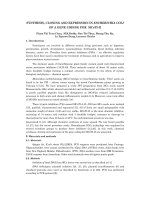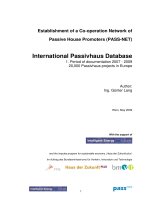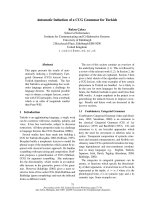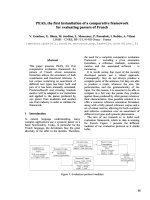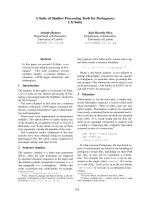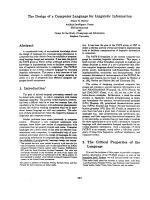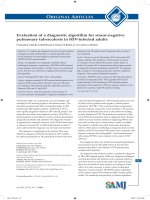ESTABLISHMENT OF A PROCESSING PROCEDURE FOR MANUFACTURING DRIED DRAGON FRUIT
Bạn đang xem bản rút gọn của tài liệu. Xem và tải ngay bản đầy đủ của tài liệu tại đây (328.37 KB, 7 trang )
<span class='text_page_counter'>(1)</span><div class='page_container' data-page=1>
Processing of dragon fruits into long-shelf life
products help reach the consumers better during
off-seasons, make more outputs for the fruit,
serve the increasing need of new products of
consumers, and as well increase the economical
of dragon fruits. To process dried dragon fruit,
solar drying is not suitable because dragon fruit
contains a high content of water (Moo-Huchin
et al., 2014). Furthermore, the solar drying time
<b>INTRODUCTION</b>
Dragon fruit trees became one of the popular
fruit-bearing trees in Vietnam. Part of dragon
fruits are consumed fresh domestically. The
other part is for exportation to China, Japan,
EU, and other countries. In recent years,
the exportation market is not stable and that
the price of dragon fruit becomes very low,
especially during the harvesting seasons.
<b>ESTABLISHMENT OF A PROCESSING PROCEDURE FOR </b>
<b>MANUFACTURING DRIED DRAGON FRUIT</b>
<i>Le Trung Thien1<sub>, Phan Tai Huan</sub>1<sub>, Katleen Raes</sub>2</i>
<i>1<sub>Nong Lam University, Ho Chi Minh City</sub></i>
<i>2<sub>Ghent University, Kortrijk, Belgium </sub></i>
<i>Email: </i>
<b>ABSTRACT</b>
<i>In recent years, consumption of dragon fruits became an issue because of the dramatic increase </i>
<i>in domestic production and the production in other countries. So it becomes urgent to develop new </i>
<i>products, which can utilize the abundant amount of fresh dragon fruit, and provides a sustainable </i>
<i>output for the domestic production. In the present study, we preliminarily developed a processing </i>
<i>procedure to manufacture dried dragon fruit. The objectives of the study were (1) to determine if </i>
<i>it is advantageous to do osmotic dehydration (OD) before hot air drying, (2) to find out a suitable </i>
<i>submerging time if OD was necessary, and (3) to evaluate stability of the product during storage </i>
<i>with or without using sodium bisulfite. The results showed that application of OD with a solution </i>
<i>of 50% sucrose and 1.5% citric acid led to 6.58% higher in product yield, 8.08% lower in volume </i>
<i>contraction, and 3 hours shorter in subsequent hot-air drying. The use of sodium bisulfite by </i>
<i>submersion of sample in 0.5 % solution before processing was necessary to prevent the growth </i>
<i>of mold and maintain sensorial quality (especially color) of the dried product. The processing </i>
<i>procedure developed from this study can be implemented in industry.</i>
<i><b>Keywords: dried dragon fruits, drying, osmotic dehydration, drying curves.</b></i>
<b>TÓM TẮT</b>
<i>Những năm gần đây việc tiêu thụ trái thanh long gặp nhiều khó khăn vì tốc độ tăng diện tích </i>
<i>trồng trọt nhanh trong nước cũng như ở các nước khác. Việc chế biến thanh long trở nên cấp thiết </i>
<i>để tận dụng nguồn trái thanh long tươi dư thừa không phù hợp tiêu thụ tươi, và góp phần tạo đầu </i>
<i>ra ổn định hơn cho ngành trồng trái thanh long trong nước. Trong nghiên cứu này, quy trình chế </i>
<i>biến thanh long sấy khơ được bước đầu thiết lập. Mục tiêu của nghiên cứu này nhằm (1) xác định </i>
<i>liệu có cần thiết nên thực hiện bước tách nước thẩm thấu trước sấy khí nóng, (2) nếu cần thì tìm </i>
<i>thời gian ngâm thẩm thấu thích hợp, và (3) đánh giá độ ổn định của sản phẩm trong q trình bảo </i>
<i>quản có và khơng có dùng sodium bisulfite. Các kết quả cho thấy việc có dùng bước tách nước </i>
<i>thẩm thấu với dung dịch đường 50% và 1,5% acid citric làm tăng tỷ lệ thu hồi lên 6,58%, giảm sự </i>
<i>co rút sản phẩm 8,08% và giảm được 3 h thời gian sấy khí nóng sau đó. Việc dùng sodium bisulfite </i>
<i>là cần thiết bằng cách nhúng nguyên liệu vào dung dịch bisulfite 0,5% trước khi chế biến để ngăn </i>
<i>sự phát triển của nấm mốc và duy trì chất lượng cảm quan (đặc biệt là màu) của sản phẩm sấy. </i>
<i>Quy trình phát triển từ nghiên cứu này có thể được áp dụng vào thực tế. </i>
</div>
<span class='text_page_counter'>(2)</span><div class='page_container' data-page=2>
in term of processing efficiency and product
quality, and (3) evaluate the changes of product
quality with and without using sodium bisulfite
during processing during one month of storage.
<b>MATERIALS AND METHODS</b>
<b>Materials</b>
Dragon fruits for experiments were
purchased at a local market. Other materials
and chemicals for the study included refined
sugar (Bien Hoa Sugar Company, Vietnam),
acid citric, and sodium bisulfite (China).
<b>Experimental processing procedure</b>
The experimental procedure is shown in
Figure 1.
would be very long which facilitate spoilage of
the product. Hot air (tray) drying is suitable to
be applied in plantation areas in Vietnam and
in other developing countries. Submersion of
the fruit into a high osmotic pressure solution
for a period of time (which is also osmotic
dehydration) helps release a part of water from
the fruit into the solution and the subsequent
hot-air drying can be shorten (Duangmal and
Khachonsakmetee, 2009; Germer et al., 2010).
The goal of this study was to preliminarily
establish a procedure to produce a dried dragon
product. To obtain that goal, experiments
were carried out to (1) evaluate the necessity
of osmotic dehydration (OD) before hot-air
drying, (2) find out suitable submerging time
<b>Dragon fruit</b>
<b>Peeling & </b>
<b>slicing</b>
<b>Hot-air drying</b>
<b>Packaging</b>
<b>7.5mm</b>
<b>65 ° C</b>
<b>Submerging</b>
<b>Rinsing</b>
<b>Product</b>
<b>Sugar 50% + </b>
<b>citric acid 1.5%</b>
Osmotic dehydration
No osmotic dehydration
<b>Figure 1. Experimental procedure for processing dried dragon </b>
fruit with and without osmotic dehydration
<b>Experiments</b>
<i><b>Effects of processing dragon fruits with and </b></i>
<i><b>without osmotic dehydration on processing </b></i>
<i><b>ef-ficiency and production quality </b></i>
Dragon fruits were peeled and sliced into
circular slices that 0.75 cm thick. These pieces
were either dried directly using a hot-air (tray)
</div>
<span class='text_page_counter'>(3)</span><div class='page_container' data-page=3>
For sensorial evaluation in experiments
1 and 2, preference test toward color, taste,
structure and general like using a hedonic 9
point scale was applied with a panel of 25
members. For experiment 3, Dou-Trio test with
twelve members was applied to check whether
sensorial properties of the dried product changed
significantly after one month of storage.
Microbial evaluation was carried out by
a third party, Hai Dang Analytical Service
Company in District 1, Ho Chi Minh City,
Vietnam.
<b>Statistical analysis</b>
All experiments were carried out in triplicate
and all analyses were performed at least twice.
Calculation, tabulating and graphing of data
were carried out using Microsoft Excel 2007
(Microsoft, USA). Statistical analysis was
performed by using JMP software version 10.0
(SAS Institute Inc, USA). The difference was
considered significant at p < 0.05.
<b>RESULTS AND DISCUSSION</b>
<b>Effects of osmotic dehydration on processing </b>
<b>efficiency and production quality </b>
Physicochemical properties of dragon fruit
before and after OD are shown in Table 1.
<b>Table 1. Physicochemical properties of dragon </b>
fruit before and after osmotic dehydration
Parameters After slicing After OD
Production yield (%)(a) <sub>65.76± 2.96 54.05± 2.38</sub>
Moisture content (%) 88.94± 1.06 78.92± 1.08
Water activity 0.980± 0.013 0.960± 0.009
Brix ° 8.92± 0.54 18.52± 0.45
pH 4.43± 0.15 4.25± 0.12
Volume contraction (%)(c) <sub>-</sub> <sub>9.03± 0.26 </sub>
<i>Data are average ± SD of three independent </i>
<i>repeats</i>
<i>(a)<sub> compared to beginning fruit weight (before </sub></i>
<i>peeling and slicing)</i>
<i>(c)<sub> volume contraction compared with slices </sub></i>
<i>before osmotic dehydration</i>
A significant weight of peel was removed.
As shown in the table, the production yield
product compared to the weight of dragon fruit
pieces before drying, (4) volume contraction of
the dried product, and (5) sensorial quality of
the products.
<i><b>Effects of osmotic submerging time on </b></i>
<i><b>processing efficiency and sensorial quality of </b></i>
<i><b>product</b></i>
Samples were processed according to the
procedure shown in Figure 1. The osmotic
submerging time was experimented with 2, 3,
4 and 5 hours. The osmotic solution contained
50% sucrose and 1.5% citric acid. After OD the
samples were dried using the hot-air dryer until
the samples reached 14% moisture content. The
products were evaluated on moisture content,
water activity, volume contraction, recovery
yield and sensorial properties.
<i><b>Evaluation of dried dragon fruit quality after </b></i>
<i><b>one month of storage </b></i>
Processing of dried dragon fruit was carried
out with and without submerging in 0.5%
sodium bisulfite solution for five minutes before
OD and hot-air drying (Figure 1). The osmotic
submerging time was according to the result
of the previous experiment. After one month
of storage in PE package at room conditions,
samples were taken to measure color, total plate
counts, total yeasts counts, total mold counts,
<i>Coliforms and for sensory evaluation. </i>
<b>Physicochemical analyses</b>
Moisture content was determined using
drying at 105 °C until a constant weight.
Brix degree (indicating dissolved solids) was
measured using an Atago Hand Refracttometer
0 – 32 on the juice obtained from grinding and
compressing the fruit/ fruit samples.
Thickness of dragon fruit slices before
and after processing was measured using the
method of replacement of toluene solvent.
Volume contraction (%) after a treatment was
determined as (V<sub>after treatment </sub>*100) / V<sub>before treatment</sub>.
</div>
<span class='text_page_counter'>(4)</span><div class='page_container' data-page=4>
contraction of the product. Water activity of the
two products was not significantly different.
The moisture reduction curves during hot-air
drying are shown in Figure 2 and images of the
two products are given in Figure 3. OD reduced
subsequent drying time because part of water
was removed during OD (Pallas et al., 2013).
0
10
20
30
40
50
60
70
80
90
100
0 1 2 3 4 5 6 7 8 9 10 11 12
Mo
ist
ur
e (
%
)
Drying time (h)
<b>Figure 2. Moisture reduction curves during </b>
hot-air drying at 65°C of dragon fruit slices
without ( ) and with ( ) previous
os-motic dehydration
<b>Figure 3. Dried dragon fruit slices without </b>
(left) and with (right) osmotic dehydration
The product obtained from processing with
using OD looked fuller and smoother than the
one without using OD (Figure 3). Part of the
surface of the product without using OD was
brown while the other product was white in
the entire surface. Such observations were
confirmed with sensorial test results (Table 3).
The product with using OD was preferred in all
attributes and had higher general preference.
The taste of the MD product was more intense
due to absorbed sugar and citric acid. The non
MD product has a rather rough structure and
decreased after OD which means that the
amount of materials migrating from the osmotic
solution into the fruit was smaller than the
amount of materials released from the fruit into
the solution. Due to concentration difference,
sucrose was expected to penetrate into the
fruit. Because of that, the Brix degree increased
significantly (Table 1). Water released from the
fruits and as shown in Table 1, the moisture
content and the weight decreased. The pH of
the fruit decreased, which could be due to the
migration of citric acid into the fruit. Water
activity decreased as the result of increase in
dissolved solids. After being further dried
with the hot-air dryer, the physicochemical
properties in dragon fruits continued to change
as shown in Table 2.
<b>Table 2. Physicochemical properties of dried </b>
dragon fruit slices obtained from hot-air drying
after with and without previous
osmotic dehydration
Parameters Without OD With OD
Product yield (%) (a) <sub>18.89± 0.77 25.47± 1.05 </sub>
Moisture (%) 14.38± 0.63 14.26± 0.58
Water activity 0.470± 0.027 0.462± 0.016
Volume contraction (%)
(b) 82.53± 2.69 74.45± 2.74
Drying time (h) 12 9
<i>Data are average ± SD of three independent </i>
<i>repeats</i>
<i>(a)<sub> compared to the weight of fruit pulp slices </sub></i>
<i>before processing.</i>
<i>(b)<sub> compared to the volume of fruit pulp slices </sub></i>
<i>before processing.</i>
</div>
<span class='text_page_counter'>(5)</span><div class='page_container' data-page=5>
and appearance compared to without using OD
(Raj et al., 2015).
plainer taste. OD of apricot before hot-air drying
also resulted in a dried product of better color
<b>Table 3. Sensorial scores of attributes of the dried dragon slices obtained </b>
from processing with and without osmotic dehydration
Attributes Without OD With OD
Color 5.08a <sub>6.88</sub>b
Taste 4.56a <sub>7.28</sub>b
Structure 3.84a <sub>7.36</sub>b
General score 5.04a <sub>7.36</sub>b
<i>Data are average scores of 25 panelists. Values on the same row do not share a common superscript </i>
<i>for a significant difference. Higher scores indicate higher preference (like level). </i>
<b>Effects of osmotic submerging time on </b>
<b>pro-cessing efficiency and product sensorial </b>
<b>qual-ity</b>
Physicochemical properties of dragon fruit
slices after varying osmotic submersion time
are shown in Table 4.
<b>Table 4. Physicochemical properties of dragon fruit slices </b>
after varying osmotic submersion time
Parameters <sub>2</sub> Osmotic submersion time (h)<sub>3</sub> <sub>4</sub> <sub>5</sub>
° Brix 17.00 ± 0.32 18.50 ± 0.47 18.50 ± 0.30 18.50 ± 0.21
pH 4.31 ± 0.12 4.24 ± 0.11 4.22 ± 0.15 4.25 ± 0.13
Moisture (%) 79.66 ± 1.28 78.88 ± 1.10 78.79 ± 1.15 78.81 ± 1.12
Water activity 0.96± 0.005 0.95± 0.007 0.95± 0.009 0.95± 0.009
Volume contraction (%)(a) <sub>7.89 ± 0.22</sub> <sub>8.95 ± 0.21</sub> <sub>9.01 ± 0.27</sub> <sub>9.09 ± 0.16</sub>
<i>Data are average ± SD of three independent repeated experiments.</i>
<i>(a)<sub> compared to fruit slices before OD.</sub></i>
The rate of migration of sucrose into the
fruit was illustrated by the increase in Brix
degree. In the fruit slices, this value doubled
to 17.00 ± 0.32 after two hours from 8.90 ±
0.48. After three hours, the Brix degree did
not increase and moisture contained did not
decrease significantly anymore (Table 4). The
subsequent hot-air drying time could not be
shortened anymore when the time for OD was
longer than three hours (Figure 4).
0
10
20
30
40
50
60
70
80
90
0 1 2 3 4 5 6 7 8 9 10 11 12
Mo
ist
ur
e (
%
)
Drying time h
<b>Figure 4. Moisture reduction curves during hot-air at 65 °C drying </b>
</div>
<span class='text_page_counter'>(6)</span><div class='page_container' data-page=6>
solution of 50% sucrose and 1.5% citric acid. An
optional extra step, submersion in 0.5% sodium
bisulfite, was introduced before OD. After OD,
the sample was dried with the hot-air dryer at
65 °C to 14% moisture. The dried product was
packed in PE bag and stored for one month in
room conditions. When submersion in sodium
*bisulfite was used, the microbial quality of the
product met Vietnamese regulation on dried
fruit for direct consumption (Table 5). In the
case of not using sodium bisulfite, the total
mold counts were higher than the limit set by
the regulation.
Sensory evaluation using a hedonic 9 point
scale also showed the same trend; preference
(like level) for three attributes (color, taste,
structure) and for general score increased with
osmotic submersion time from 0 to 2 and 3h and
did not increase significantly anymore (data not
shown) when submerging time was increased
further to 4 and 5 h.
<b>Changes of dried dragon fruit after one </b>
<b>month of storage</b>
Based on the results of previous experiments,
OD was carried out with 3h of submersion in
<b>Table 5. Microbial quality of dried dragon slices </b>
after one month of storage in PE bag at room conditions
Parameters Unit No sodium <sub>bisulfite</sub> with sodium bisulfite QĐ 46:2007 QĐ/<sub>BYT</sub><sub>(a)</sub>
Total plate counts CFU/g 5.0 x 102 <sub>6.0 x 10</sub>1 <sub>10</sub>4
<i>Coliforms</i> CFU/g Not detected<sub>(LOD = 10)</sub> Not detected<sub>(LOD = 10)</sub> 10
Total yeast counts CFU/g 1.0 x 101 Not detected
(LOD = 10) 102
Total mold counts CFU/g 5.5 x 102 Not detected
(LOD = 10) 102
<i>(a)<sub>Regulation of Vietnam Ministry of Health on dried fruits for direct consumption. LOD ~ limit of </sub></i>
<i>detection</i>
Using sodium bisulfite also stabilized the
color of the dried product (Figure 5). Whereas
when sodium bisulfite was not applied, there
were significant changes in L*<sub> and a</sub>* <sub>values </sub>
(Figure 5). L* <sub>represents lightness of sample, </sub>
and that the decrease in L*<sub> indicated a darker </sub>
color of the samples. a*<sub> and b</sub>*<sub> range from green </sub>
to red and blue to yellow, respectively. The
sample without bisulfite became darker (lower
L*<sub> value), greener (lower a</sub>*<sub> value) and tended </sub>
to be more yellow after one month of storage.
A Duo-Trio sensorial test was carried out
to check whether the panelists were able to
distinguish the difference between
</div>
<span class='text_page_counter'>(7)</span><div class='page_container' data-page=7>
the dried product. There is a need to investigate
the possibilities to reuse and/or utilize the used
osmotic solution and to investigate the changes
of product quality for a longer storage time.
<b>ACKNOWLEDGEMENT</b>
This study was financially sponsored by
VLIR-UOS through South Initiative Project
2014-128/ZEIN2014Z178.
<b>REFERENCES</b>
De Medeiros R. A. B., Z. M. P. Barros, C.
B. O. De Carvalho, E. G. F. Neta, M. I. S.
Maciel, and P. M. Azoubel. 2016. Influence
of dual-stage sugar substitution pretreatment
on drying kinetics and quality parameters of
<i>mango. Lwt-Food Science and Technology </i>
<i>67:167-173.</i>
Duangmal K. and Khachonsakmetee S. 2009.
Osmotic dehydration of guava: influence of
replacing sodium metabisulphite with honey
<i>on quality. International Journal of Food </i>
<i>Science and Technology 44, 1887–1894.</i>
Germer S. P. M., M. R. Queiroz, J. M. Aguirre,
S. A. G. Berbari, and V. D. Anjos. 2010.
Process variables in the osmotic dehydration
<i>of sliced peaches. Ciencia E Tecnologia De </i>
<i>Alimentos 30(4):940-948.</i>
Moo-Huchin, V. M., I. Mota, R.
Estrada-Leon, L. Cuevas-Glory, E. Ortiz-Vazquez,
M. D. V. Y. Vargas, D. Betancur-Ancona, and
E. Sauri-Duch. 2014. Determination of some
physicochemical characteristics, bioactive
compounds and antioxidant activity of
<i>tropical fruits from Yucatan, Mexico. Food </i>
<i>Chem. 152:508-515.</i>
Pallas L. A., R. B. Pegg, and W. L. Kerr. 2013.
Quality factors, antioxidant activity, and
sensory properties of jet-tube dried rabbiteye
<i>blueberries. Journal of the Science of Food </i>
<i>and Agriculture. 93(8):1887-1897.</i>
Raj D., P. C. Sharma, and S. K. Sharera.
2015. Studies on Osmo-air dehydration of
different Indian apricot (Prunus armeniaca
<i>L.) cultivars. Journal of Food Science and </i>
<i>Technology-Mysore 52(6):3794-3802.</i>
Before
storage One monthstorage
<b>54,66</b>
<b>47,01</b>
<b>54,87</b> <b>52,83</b>
0
10
20
30
40
50
60
<b>L *</b>
<b>-0,26</b>
<b>000</b>
<b>-0,28</b> <b><sub>-0,31</sub></b>
-0,5
-0,4
-0,3
-0,2
-0,1
0
<b>a*</b>
<b>7,59<sub>7,53</sub></b> <b>7,78</b> <b><sub>7,55</sub></b>
6,5
7
7,5
8
8,5
<b>b*</b>
<b>Figure 5. Changes of color parameters of dried </b>
dragon slices with ( ) and without ( ) using
sodium bisulfite during processing
after one month of storage in PE bag
under room conditions.
<b>CONCLUSIONS</b>
</div>
<!--links-->
